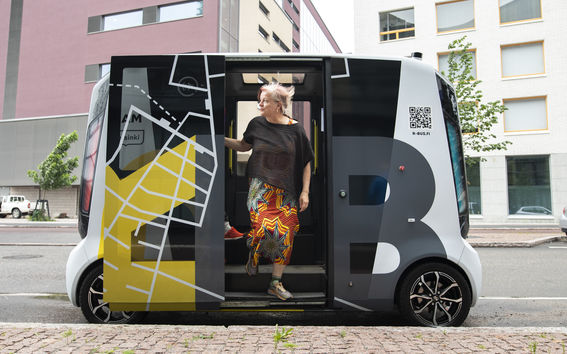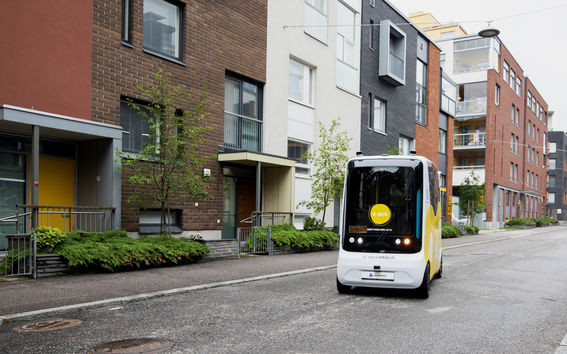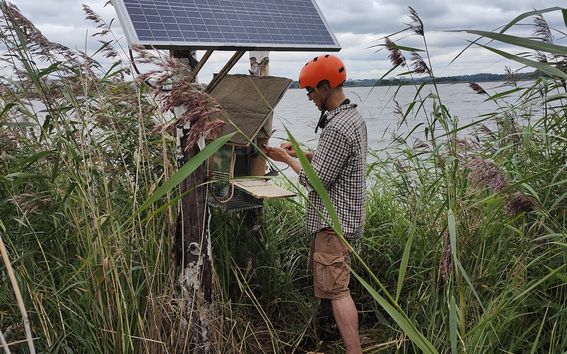The self-driving R-Bus, circling random routes, served as a mobile art installation

In August 2023, a special art installation took over the streets of Kalasatama. The R-Bus, guided by algorithms, travelled between four stops, randomly selecting its routes to add variety to each journey.
The R-Bus project was a success on many levels. During the project, the bus ran for a total of 17 days, and attracted more than 1100 visitors.
"This was an impressive number, considering that the bus only had room for six people at a time. The bus was constantly bustling with people queuing at the bus stop waiting to get on," says Laura Beloff, Assistant Professor of Art and Media, who was responsible for the project.
Beloff noticed how people, while riding the bus, quickly began to trust the technology, and how the technological system decided for you.
"The ride was taken as a journey rather than a transfer. The attitude towards tech clearly divided people. The experiment forced people to reflect on their opinion of this kind of transport."
The comments about the project showed a split between for and against this kind of development in traffic.

The urban environment required lengthy permit processes
Laura Beloff is passionate about the concept of intelligence and artificial intelligence, particularly their development in recent years. She was particularly interested in how these things had changed in recent years. Her interest took concrete form in the Smart Bus project.
"I would use the term 'feeble intelligence'. The bus was intelligent, but at the same time it lacked the biological intelligence that animals, for example, have."
Originally, the idea was even more radical, with a plan for the City of Helsinki to have a bus that would go to a totally random direction. Kalasatama was chosen for the project because of Helsinki's 'percent principle' where 1% of the area's building costs are allocated to the arts. This set the conditions for the bus routes.
"The project proved to be complex with roadworks and city construction happening in the area, and the surroundings changed weekly. The permitting processes were a hassle, and the companies and businesses that were attracted to get involved were divided in many ways," says Beloff.
Bus makers and coders were important, as was the operator, which was in short supply. Estonian company Auve.tech was involved in the development of the bus and the software.
"The safety drivers were necessary so that someone could take over the manual control in case of an emergency," says Beloff.

Soundscapes of virtual ecosystems
Inside the bus, passengers were treated to a special audio performance with or without headphones, where they could hear real-time audio streams of the natural environment up close, complemented by machine learning.
"The piece never sounded the same twice. In it, real sounds were mixed and machine learning was used to create an "audio channel" of the situation in the stream. In the piece, the technological and the organic (biological) meet", says Laura Beloff.
The idea is based on Bernie Krauss's theory that different organisms in the natural environment sound at different frequencies.
"The machine learning system could create a new “creature” that would then try to survive and evolve on its own frequency", says Calvin Guillot Suarez, whose Masters Thesis the sound performance was.
The sound sensors were set up on the north side of Kalasatama, near Sompasauna in an area that is a sort of wasteland.
"There was an interesting variance of sounds depending on the time of the day or weather. We did tests at night where there were some very interesting sounds of the night", says Guillot Suarez.
In an urban area, human infrastructure reserves sound frequencies with sounds such as traffic and people walking by. The sounds created by machine learning are based on the empty spaces left over, where the sounds of "new organisms" were created.
"Lower frequencies could have sudden sounds such as low rumble from a construction site that made it harder for animal sounds to adapt and survive. Higher sounds were more available, which is why bird or insect sounds survived and were more common", explains Guillot Suarez.
"Maybe at one point in time there were sounds in the nature at these frequencies too", ponders Beloff.
"The work is a reflection of what the world is like for other organisms. We were not so much thinking about a general aesthetic, but producing a concept. A bit more filtering and quizzing was required towards the end", says Beloff.
"This is a playful way of dealing with a serious issue, but the critique is there below. Why do we dominate and have to decide for other species? In my work I try to create a situation that asks questions and leaves you wondering", she continues.


The moving installation is exceptional
As an artist, Laura Beloff found this project particularly interesting because it broke the traditional boundaries of public art.
"The installation was not permanent, but event-based, which made it unusual in the context of public art. In museum art exhibitions, the audience is usually selective and heterogeneous, but in this case the art audience could be people from the street. This created a new and fascinating interaction between art and the public," she says.
The project showed that art can be accessible to everyone, not just a select audience, and this made it an enjoyable experience for all involved.
Beloff hopes to try the same project in a different setting in the future and develop further work on the same theme. At the moment, there is no information about the future of the project.
"It would be great to try to replicate the project in a completely different enviroment."
The R-Bus project team included Laura Beloff, Marko Tandefelt, Petri Ruikka, Jani Hietanen, Calvin Guillot Suarez, Sebastian Schlecht, Andrea Mancianti, John W. Fail, Esther Saraste and Auve.tech & Rolan.
- Published:
- Updated:
Read more news

Get to know us: Associate Professor Maria Sammalkorpi
Sammalkorpi received her doctorate from Helsinki University of Technology 2004. After her defence, she has worked as a researcher at the Universities of Princeton, Yale and Aalto.
Aalto computer scientists in ICML 2024
Computer scientists in ICML 2024
Getting bacteria into line
Physicists use magnetic fields to manipulate bacterial behaviour